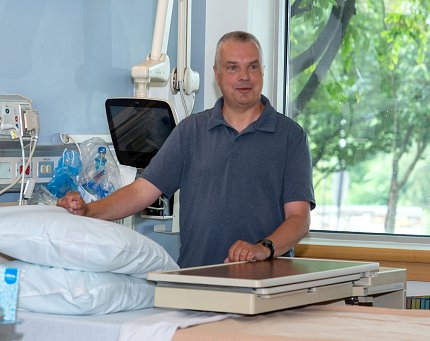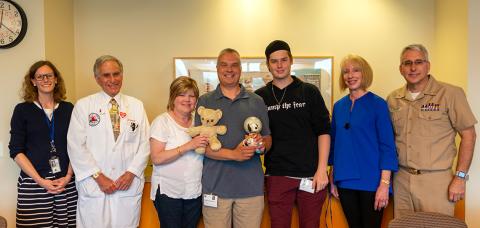Grateful Patient Returns to NIH After 50 Years

Photo: Mena Brunette
In 1969, when Tom Kaminski was 7 years old, he had what doctors simply described as a hole in his heart. Officially, it was a congenital heart defect known as tetralogy of Fallot, which caused oxygen-poor blood to flow through his body and turn his lips and fingernails blue. But for Tom—a fragile, underweight kid unable to run, bike or play ball—the details of his diagnosis were the least of his concerns. The only thing he wanted was to be like the rest of the children in his New Jersey neighborhood.
Then in July—on the same day Apollo 11 launched its dramatic mission to the moon—Kaminski got his wish.
In a state-of-the-art surgical room of the Clinical Center, where Kaminski’s parents had brought him in desperation, renowned cardiac surgeon Dr. Andrew “Glenn” Morrow successfully repaired Tom’s damaged heart. Less than a week later, Morrow sent the youngster on his way, confidently predicting in his medical notes that the boy would “derive good benefit” from the complex surgery he’d just done.

Photo: Mena Brunette
“This place gave me a new beginning, and I am so grateful,” he told a half-dozen or so NIH staffers who welcomed him back. Last month, on the 50th anniversary of that milestone day, Kaminski was back at NIH, this time with his wife and son, to prove he not only got “good benefit,” but to say thanks for the gift of a healthy life.
It was an emotional visit not just for the 57-year-old Kaminski, now a veteran helicopter traffic reporter for WCBS 880 radio in New York City, but also for doctors and researchers at the National Heart, Lung, and Blood Institute who gathered to hear his story. “We’re thrilled to have you here,” said Dr. Gail Pearson, associate director of NHLBI’s Division of Cardiovascular Sciences. “You are a reminder of why we do what we do every day.”
Kaminski’s visit was part tour—Dr. David Henderson, deputy director for clinical care at the CC, led the way, noting some of the profound ways the center has changed in 50 years, especially for children. It was part testimonial—Kaminski offered up his story to NIH museum designer Hank Grasso for the NIH patient archives. And it was part tutorial, as Pearson and other scientists and researchers shared some of the head-spinning progress that has been made in pediatric cardiac care over the decades.
“We’re doing a much better job of keeping infants alive—and thriving,” said Pearson, who also is director of NHLBI’s Adult and Pediatric Cardiac Research Program. Today, NHLBI awards some $122 million annually in research grants to help boost these kinds of efforts and learn even more about congenital heart diseases and how to treat them. That support has helped fuel a five-fold decline in congenital heart disease-related infant deaths since the 1940s.

Photo: Mena Brunette
Kaminski told the group he was just happy to be the beneficiary of the skills of the “awesome” NIH doctors and staff he insists saved his life and made him “normal.”
“It was like somebody opened up a door and said, ‘Okay, there’s the world you couldn’t be part of—go out there and be a part of it!’” he said.
To read more about Kaminski’s story, visit https://www.nhlbi.nih.gov/news/2019/coming-home-former-patient-marks-50th-anniversary-his-surgery-nih.
